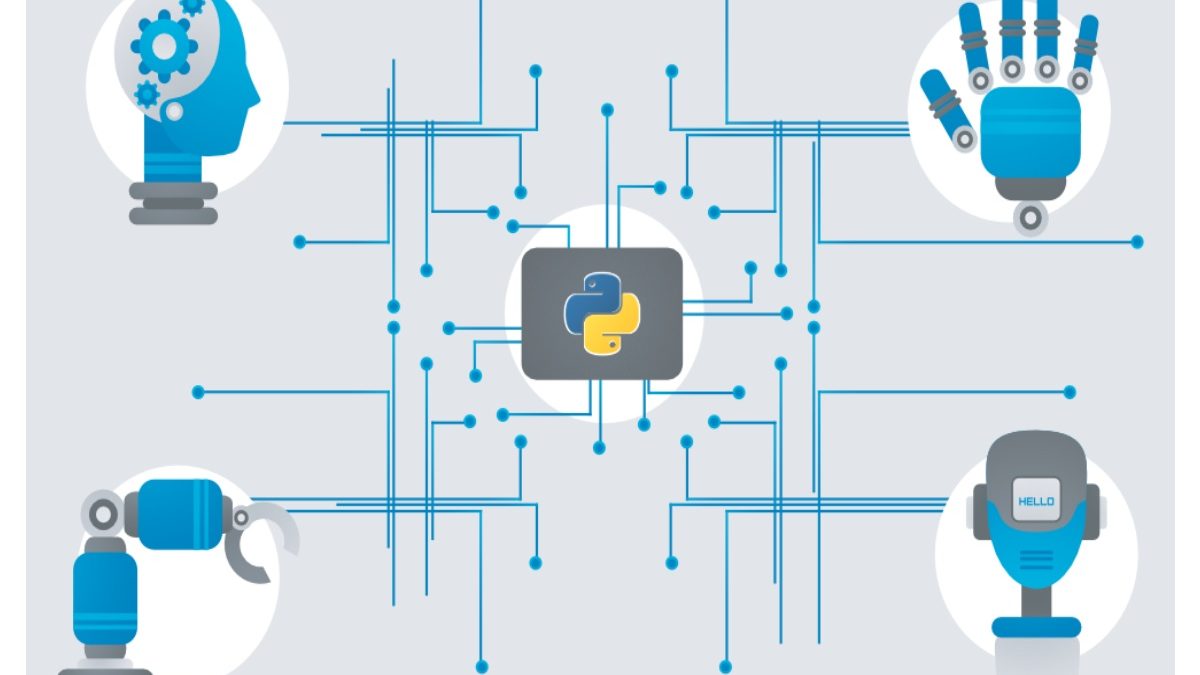Why Python for machine learning? – Artificial intelligence (AI) and Machine learning (ML) based projects are growing by the day due to their efficiency, accuracy, and better user experience. It also helps in saving time and replacing cumbersome manual tasks. Some examples of such applications are our smartphones, semi-automated cars, traffic-sensitive signaling systems, robotics, car assembly lines, medical diagnosis systems such as Magnetic resonance imaging (MRIs), Computed tomography (CT) scans, and more. How do these applications work, respond and behave smarter than humans?
AI and ML systems have the hardware, big databases, a software program with trained algorithms, and an interface that allows the trained algorithms to understand and respond as per its training to the data set fed to it. Hence, the programming language is crucial to the performance of these systems. One such language is Python, and we are about to discover what makes Python the best language for AI and ML systems.
Python developer performs a unique relevant test task. To be successful as a Python developer, you should possess in-depth knowledge of object-relational mapping, experience with server-side logic, and above-average knowledge of Python programming.
Table of Contents
Why Python?
All software projects are not AI projects since AI and ML projects use a different skill-set to train and use the algorithms in the technology stack. This means that the programming language used should be capable of being used with neural networks, highly technical deep research, etc., while being flexible, stable, and having various tools. Python brings all this to the table and more. Its language uses the English syntax, making possible many Python AI projects being implemented today.
Python also scores when it comes to deployment, development, and maintenance. It offers AI-based projects access to great libraries, consistency, simplicity, and works on various frameworks used in ML and AI. Besides, it is flexible, independent of the platform, and has a great support community. No wonder specialists in machine learning and artificial intelligence prefer Python over languages like R, Scala, Java, and more.
Features of Python:
Consistent and simple:
Python’s code is readable and concise while being suitable for versatile workflows and complex AI and machine learning algorithms. Its simplicity and English syntax permit the developers to focus on ML issues, script, and train algorithms for a reliable ML system while saving time on the language’s sometimes complex technical nuances. Plus, it is easy to learn. Developer’s love its human-readable code, helping them in creating better ML models.
According to programmers, Python is very intuitive and surpasses other programming languages. It also has various libraries, frameworks, extensions, etc., making functionality implementation much easier. It scores when multiple developers collaborate in the implementation. Being a general-purpose language, Python is great at doing complex ML and AI tasks by helping build prototypes required for quick product testing.
Large choice of frameworks and libraries:
The implementation of algorithms used in ML and AI are time-consuming and complex, requiring a well-tested and structured ecosystem for developers to create the best solution of code. To reduce development time, Python’s many libraries and frameworks are used by programmers. Python also has a technology stack that is extensive and rich.
Some of these are:
- TensorFlow, Scikit-learn, Keras for ML.
- Data analysis and scientific computing using NumPy.
- Advanced computing using SciPy. This allows complex operations with regression, clustering, and classification algorithms and supports random forests, k-means, vector machines, gradient boosting, and Density-based spatial clustering of applications with noise (DBSCAN) when used with the scientific and numerical libraries SciPy and NumPy in Python.
- General-purpose analysis of data using Pandas.
- Data visualization using Seaborn.
Independent of Platform:
Python as a language is platform-independent. Python’s platform independence allows its framework and programming language to be implemented on one machine while using another machine with minimal changes. It is widely supported by platforms like Windows, MAC- OS. Linux etc., allowing Python to create executable programs for the OS or operating systems that are standalone.
This also infers that the Python software is distributed easily and can be used on the OS without using a Python interpreter. Using Python also means that developers have access to computing with Amazon or Google services. In the business world, many data scientists use their GPUs or Graphics Processing Units to train their algorithms and ML models using Python, which reduces training efforts and costs.
Popularity:
Python was rated as one of the top 5 popular languages in programming at the Stack Overflow’s Developer Survey 2020. It’s also possible to hire a development company to build your AI-based project replete with the necessary skill sets. Are you aware that Google’s web page crawling, movies from Pixar, and song recommendations by Spotify use Python? According to a survey, Python is the most used and preferred web development language. Python’s repositories available online have a huge 140,000 customized software packages like SciPy, Numpy, Matplotlib, etc., which are ready-to-use and easy in a Python program. These packages are also widely used by ML developers to find patterns in Big Data sets.
Great support Community:
The Python ML and AI community have a global support community with Python forums. For driving real-time experience exchange of machine learning solutions. This means that for most issues you may face, there is someone in that community who has dealt with the same problem before. Besides, you get guidance, advice, and support from a large and diverse Python community anywhere and anytime.
Other ML programming languages:
AI and ML are evolving and developing very fast. Though Python leads the pack, many languages are also used and popular in the ML languages landscape. Some of the developer’s favorites while using programming languages are discussed below.
R:
R is typically a popular language if you need to manipulate, analyze. Or use statistical analysis operations on data and Big Data. Its packages like the RODBC, Gmodels, Tm, Class, etc., are popular with both programmers and developers. The algorithms so developed are easy and quick to implement and are hassle-free. R can also handle data from an Internet of Things (IoT) device or financial models. Its charts and graphs are high quality, and if used with ggvis, ggplot2, googleVis, rCharts, Shiny, etc. can turn simple visuals into complex web applications. Its main issue is that it lags and is sometimes slow when handling Big Data. Thus, where Java or Python fare better for their flexibility in product development.
Java:
Java is portable, object-oriented, transparent, maintainable, and supported by many libraries like Rapidminer, WEKA, etc. It is used for NLP applications, neural networks, and search engine algorithms. It also has a comprehensive support community and permits the building of systems on a large scale. But visualization and statistical modeling are hard in Java. Python fares better since it has more tools, libraries, and frameworks to its credit.
Conclusion:
Python is an excellent choice as a programming language since it drives the ML and AI solutions providing personal assistants, recommendation systems, spam filters, search engines, and fraud detection systems with a simple, reliable and consistent solution. The near future will see more Product Owners building newer apps that need to perform well and are driven by innovative Machine Learning and Artificial Intelligence solutions. This then means the algorithms get smarter and have to act more like humans than ever before. Thus the demand for professionals with a good grasp of Python and its frameworks, libraries, etc., is set to explode. And, in high-demand situations, the pay is bound to be better.
So if you wish to learn more about machine learning and artificial intelligence, enroll in online AI & machine learning courses that permit you to learn at your own pace and are offered by a reputed institution. Great Learning offers a 7-month PG Course that comes with mentorship, career, and placement support. The comprehensive syllabus believes in practical hands-on experience on projects with industry relevance. So reliable is the course that most people who made their careers with it are already leading the pack with 48% more salary! Don’t miss out on an opportunity to make your career in the field of Machine Learning if you are a fresh graduate or working professional. Hurry!
Related posts
Addressing Mental Health in Spine Surgery Recovery
Recovery from spine surgery is a journey that extends far beyond the physical aspects of healing. It’s a comprehensive process…
What Areas Can You Target With Coolsculpting?
Are you a healthy and active person but still have some unwanted fat that never seems to go away? If…
How Does Vagus Nerve Stimulation Work?
How Does Vagus Nerve Stimulation Work? – Vagus nerve stimulation (VNS) is a treatment used for various conditions like epilepsy…
Addressing Challenging Behaviour with Positive Behaviour Support
Positive Behaviour Support: As our understanding of behavioural psychology evolves, so too do the strategies we employ to manage and…
How Long Does the Probate Process Take? Your Probate Questions Answered
Probate Process: There is a lot involved with the probate process. It’s typically complex, leading many to seek the services…
The Prefect Gifts For Wine Connoisseurs
Anyone who has a deeply entrenched love and obsession for a certain hobby are brilliant people to buy gifts for,…







